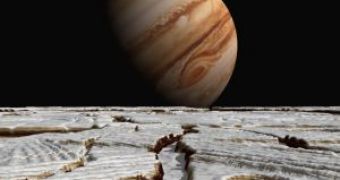Scientists are looking for E.T. on Mars but a group of researchers believe that it could be found on Jupiter's third moon, the icy moon Europa.
"Because of the well-supported presence of water ice on Europa and the probability that there are briny oceans, Europa has to be a major target for the search for life in the solar system," said paleobiologist Jere H. Lipps, professor of integrative biology at the University of California, Berkeley. "Many of us are proposing that there is habitat there where we can expect to find evidence of life."
Lipps has 14 years of experience in studying life in frozen Antarctic and Arctic environments with a vast knowledge on the bizarre environments organisms can thrive, and the phenomena that can expose life from deep under the ice to the surface.
This would be the situation in Europa, found to possess a water ocean covered by an ice pack that could be miles thick. "Life thrives in ice, it doesn't mind at all," said Lipps.
Only that those E.T. would be like some microbes. "In Antarctica, every phylum of algae, protozoan, bacteria and animal lives in the ice, many of them in brine channels that don't freeze."
In fact, under the ice shelves there thrive not only microscopic organisms, but also large ones like clams, snails, sponges and even fish larvae.
Photos taken by the Galileo spacecraft showed a highly fractured ice surface on Europa with domes and ridges and uptilted ice rafts and these turns in the ice surface can expose organisms from under the ice surface, like on the Earth.
Lipps found 25 likely habitats for life on Europa, based on his polar researches. As life on Europa could be very different from what we are familiarized to, "the strategy of seeking and exploring habitats, rather than the life itself, should provide a most powerful search strategy".
Liquid water near the freezing point could exist on Europa due to heat delivered by tidal friction between Europa and the huge Jupiter. "Based on analogy with Earth's polar seas, Europan life may occur in many habitats: on soft and rocky bottoms at the ocean's floor, associated with hydrothermal vents on the floor of the oceans, at different levels in the water column as plankton and nekton, and in and on the ice cover itself," Lipps noted. "Some of these might contain complex associations of life forms, including both micro- and macroscopic forms and consumers and predators."
Zones of ice turned on its edge could present evidence of past or present life, containing habitats with life or fossils. If radiation at Europa's surface could be powerful enough to destroy life forms, its action goes no further than a meter or two. "A sampling strategy for life and its history on Europa should include paleontological, molecular biological, and volatile and organic chemical objectives that would clearly document the present and/or former existence of life on Europa," he said. "If we start planning now, we could perhaps have a spacecraft on Europa in 15 years. We'd like a mission to Europa, and we've pointed out the likely places for life," Lipps said.
Image credit: Walter Meyers. Jupiter seen from Europe

 14 DAY TRIAL //
14 DAY TRIAL //